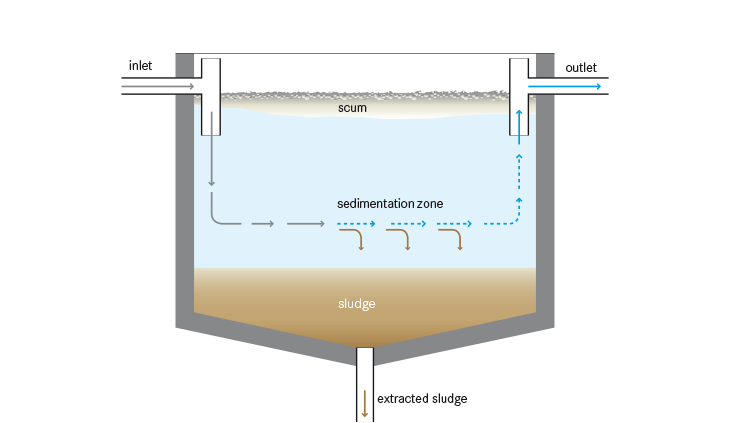Definition and Objective of Sedimentation [1]
Sedimentation is defined as a unit operation in which suspended particles are separated from a suspension by gravitational settling .Coagulation involves the addition of chemicals to induce faster aggregation and settling of initially finely divided suspended and colloidal particles. The objective of sedimentation is to remove settleable particles from suspensions either with or without the addition of chemicals. When no chemicals are added to the process, it is called plain sedimentation.
Plain sedimentation is usually employed in wastewater treatment, whereas in water treatment plants, sedimentation, in most cases, is preceded by chemical coagulation.
Sedimentation is also employed, to a limited scale, in separating particulates from air streams.

Significance of Sedimentation in Water and Wastewater Treatment [1]
Sedimentation is a major unit operation that is employed at almost every water- and wastewater-treatment plant. In water purification plants the turbidity of water must be reduced to levels as low as possible. Usually a turbidity of 1.5 units is considered desirable for water introduced into filters. This is achieved either by plain sedimentation or by coagulation followed by sedimentation. Plain sedimentation usually requires a long time to be effective in water-treatment operations, so chemicals are added to induce floc formation and the flocs then settle rapidly. At a wastewater-treatment plant, sedimentation in the primary settling tank reduces the load on subsequent treatment units.
Sedimentation in secondary settling tanks is most important as it removes a large percentage of the suspended solids from the treated wastewater, which would otherwise be carried into the effluent and then into the streams to which the effluent is usually discharged.
Sedimentation in sludge thickeners is also very important in reducing the amount of water retained by sludge. As sludge is thickened, its volume is reduced considerably, with the result that a smaller sludge digester or less sludge dewatering equipment is required. For example, a 1% sludge thickened to 3% would occupy approximately one third of the original volume, thereby reducing the sludge to be handled by over 66%.
Theory of Sedimentation
All particles suspended in a fluid of lower density tend to settle under the influence of gravity. Table 1 lists the settling velocities of suspended particles in still water. The rate of settling depends on the shape, size, and specific gravity of the particles, as well as the viscosity, temperature, and quiescence of the liquid.
Coarse and heavy particles settle rapidly and can be removed by storage in large tanks. Fine particles, 10 μm or less in diameter and with a density a little above that of water, cannot be economically removed by sedimentation alone. These particles require coagulation by the addition of chemicals to increase the effective particle size, which results in an increased rate of settling.
In the field of environmental engineering, the principles of sedimentation are applied in both water and wastewater treatment. In the treatment of surface waters, sedimentation is employed after coagulation and before filtration. In the treatment of wastewater, sedimentation principles are employed in the design of grit chambers, primary settling tanks, secondary or final settling tanks, and gravity sludge thickeners.
Table 1
Settling Velocities of Suspended Particles in Water (a)
| Diameter of particle (μm) | Approximate time required to settle 1 m | Typical material |
| 10.000 | 1.2 s | Gravel |
| 1000 | 9 s | Coarse sand |
| 100 | 2 min | Fine sand |
| 10 | 2 h | slit |
| 1 | 6 d | Bacteria |
| 0.1 | 800 d | Clay particles |
| 1.01 | 250 yr | Color bodies |
(a ) Temperature 10oC, spherical particles, specific gravity = 2.65, same chemical characteristics, quiescent conditions.
General Consideration and Basis of Design for Sedimentation tank [2]
Sedimentation is applied in wastewater treatment in three different kinds of tanks.
These are primary sedimentation tanks, secondary or final sedimentation tanks, and gravity thickeners for sludge concentration. Although the theory of sedimentation is the same in both water and wastewater treatments, sedimentation in wastewater treatment differs from that in water treatment in the following aspects:
- More suspended solids in wastewater.
- Wastewater suspended solids are usually of lower specific gravity.
- Size of particles is larger.
- Normally no chemicals are employed.
- Effluent from wastewater sedimentation tanks usually contains more suspended solids than that from water sedimentation tanks.
- Sludge has to be removed continuously to prevent septic condition.
By
Ahmed Ahmed Elserwy
Water & Environmental Consultant
Ain Shames University, Faculty of Science
References
[1]Lawrence K. Wang, Physicochemical treatment processes, Humana Press Inc, Totowa, New Jersey 0751,2004.



